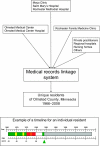Use of a medical records linkage system to enumerate a dynamic population over time: the Rochester epidemiology project
- PMID: 21430193
- PMCID: PMC3105274
- DOI: 10.1093/aje/kwq482
Use of a medical records linkage system to enumerate a dynamic population over time: the Rochester epidemiology project
Abstract
The Rochester Epidemiology Project (REP) is a unique research infrastructure in which the medical records of virtually all persons residing in Olmsted County, Minnesota, for over 40 years have been linked and archived. In the present article, the authors describe how the REP links medical records from multiple health care institutions to specific individuals and how residency is confirmed over time. Additionally, the authors provide evidence for the validity of the REP Census enumeration. Between 1966 and 2008, 1,145,856 medical records were linked to 486,564 individuals in the REP. The REP Census was found to be valid when compared with a list of residents obtained from random digit dialing, a list of residents of nursing homes and senior citizen complexes, a commercial list of residents, and a manual review of records. In addition, the REP Census counts were comparable to those of 4 decennial US censuses (e.g., it included 104.1% of 1970 and 102.7% of 2000 census counts). The duration for which each person was captured in the system varied greatly by age and calendar year; however, the duration was typically substantial. Comprehensive medical records linkage systems like the REP can be used to maintain a continuously updated census and to provide an optimal sampling framework for epidemiologic studies.
Figures




References
-
- Porta MS. A Dictionary of Epidemiology. 5th ed. Oxford, United Kingdom: Oxford University Press; 2008. International Epidemiological Association.
-
- Kendrick S, Clarke J. The Scottish record linkage system. Health Bull (Edinb) 1993;51(2):72–79. - PubMed
-
- Kendrick SW, Douglas MM, Gardner D, et al. Best-link matching of Scottish health data sets. Methods Inf Med. 1998;37(1):64–68. - PubMed
Publication types
MeSH terms
Grants and funding
LinkOut - more resources
Full Text Sources
Other Literature Sources

